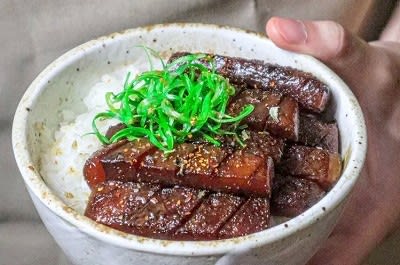
Konjac is a root vegetable that grows in parts of Asia. It’s known for its starchy corm, a tuber-like part of the stem that grows underground. The corm is used to make a rich source of soluble dietary fiber known as glucomannan. Konjac is a common name of the East and Southeast Asian plant Amorphophallus konjac.
In Japanese cuisine, konjac appears in dishes such as oden. It is typically mottled grey and firmer in consistency than most gelatins. It has very little flavor; the common variety tastes vaguely like salt, usually with a slightly oceanic taste and smell (from the seaweed powder added to it, though some forms omit the seaweed). It is valued more for its texture than flavor. Recently, you may find it in grocery stores as shirataki noodles.
Japanese konnyaku is made by mixing konjac flour with water and limewater. Without additives for color, konjac is white. It is then boiled and cooled to solidify. Konjac made in noodle form is called shirataki and used in foods such as sukiyaki and gyūdon.
Konjac jelly highly viscous and is responsible for many of its putative health benefits as used in traditional Chinese medicine, detoxification, tumour-suppression, blood stasis alleviation, asthma management, treatment of skin disorders, and phlegm liquefaction. Fiber is filling. Eating it regularly helps keep you fuller longer, so you’re less likely to overeat or snack between meals. Konjac also expands in the stomach to help keep you full.
konjac steak




























※コメント投稿者のブログIDはブログ作成者のみに通知されます